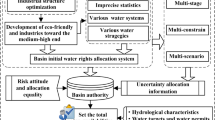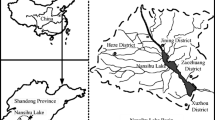Abstract
In this study, a scenario-based interval-stochastic fraticle optimization with Laplace criterion (SISFL) method is developed for sustainable water resources allocation and water quality management (WAQM) under multiple uncertainties. SISFL can tackle uncertainties presented as interval parameters and probability distributions; meanwhile, it can also quantify artificial fuzziness such as risk-averse attitude in a decision-making issue. Besides, it can reflect random scenario occurrence under the supposition of no data available. The developed method is applied to a real case of water resources allocation and water quality management in the Kaidu-kongque River Basin, where encounter serve water deficit and water quality degradation simultaneously in Northwest China. Results of water allocation pattern, pollution mitigation scheme, and system benefit under various scenarios are analyzed. The tradeoff between economic activity and water-environment protection with interval necessity levels and Laplace criterions can support policymakers generating an effective and robust manner associated with risk control for WAQM under multiple uncertainties. These discoveries avail local policymakers gain insight into the capacity planning of water-environment to satisfy the basin’s integrity of socio-economic development and eco-environmental sustainability.






Similar content being viewed by others
References
Aldea CC, Draghici A (2014) Some considerations about trust in virtual teams through the ICT tools used. International Conference - New face of TMCR, Modern Technologies, Quality and Innovation, 24–26 May 2012, Sinaia, Romania, 17–20
Brouwer R, Hofkes M, Linderhof V (2008) General equilibrium modeling of the direct and indirect economic impacts of water quality improvements in the Netherlands at national and riverbasin scale. Ecol Econ 66:127–140. doi:10.1016/j.ecolecon.2007.11.015
Dutta S, Sahoo BC, Mishra R, Acharya S (2016) Fuzzy stochastic genetic algorithm for obtaining optimum crops pattern and water balance in a farm. Water Resour Manag 30:4097–4123. doi:10.1007/s11269-016-1406-7
Green M, Weatherhead EK (2014) Coping with climate change uncertainty for adaptation planning: an improved criterion for decision making under uncertainty using UKCP09. Clim Risk Manage 1:63–75. doi:10.1016/j.crm.2013.11.001
Huang GH, Loucks DP (2000) An inexact two-stage stochastic programming model for water resources management under uncertainty. Civ Eng Environ Syst 17:95–118. doi:10.1080/02630250008970277
Huang Y, Li YP, Chen X, Ma YG (2012) Optimization of irrigation water resources for agricultural sustainability in Tarim River basin, China. Agr Water Manage 107:74–85. doi:10.1016/j.agwat.2012.01.012
Inuiguchi M, Ramík J (2000) Possibilistic linear programming: a brief review of fuzzy mathematical programming and a comparison with stochastic programming in portfolio selection problem. Fuzzy Sets Syst 111:3–28. doi:10.1016/S0165-0114(98)00449-7
Laplace PS (1951) A philosophical essay on probabilities. Dover, New York
Li YP, Huang GH (2008) Interval-parameter two-stage stochastic nonlinear programming for water resources management under uncertainty. Water Resour Manag 22:681–698. doi:10.1007/s11269-007-9186-8
Li YP, Huang GH (2009) Fuzzy-stochastic-based violation analysis method for planning water resources management systems with uncertain information. Inform Sciences 179:4261–4276. doi:10.1016/j.ins.2009.09.001
Li YP, Huang GH, Nie SL (2006) An interval-parameter multistage stochastic programming model for water resources management under uncertainty. Adv Water Resour 29:776–789. doi:10.1016/j.advwatres.2005.07.008
Liu B, Liu YK (2002) Expected value of fuzzy variable and fuzzy expected value models. IEEE T Fuzzy Syst 10:45–50. doi:10.1109/TFUZZ.2002.800692
Nematian J (2016) An extended two-stage stochastic programming approach for water resources management under uncertainty. J Environ Inf 27(2):72–84. doi:10.3808/jei.201600334
Pažek K, Rozman Č (2009) Decision making under conditions of uncertainty in agriculture: a case study of oil crops. Journal Poljoprivreda (Osijek) 15:45–50
Peterson GD, Graeme SC, Stephen RC (2003) Scenario planning: a tool for conservation in an uncertain world. Conserv Biol 17:358–366. doi:10.1046/j.1523-1739.2003.01491.x
Swarta RJ, Raskinb P, Robinsonc J (2004) The problem of the future: sustainability science and scenario analysis. Glob Environ Chang 14:137–146. doi:10.1016/j.gloenvcha.2003.10.002
Tanaka H, Guo P, Zimmermann HJ (2000) Possibility distributions of fuzzy decision variables obtained from possibilistic linear programming problems. Fuzzy Sets Syst 13:323–332. doi:10.1016/S0165-0114(98)00463-1
Ternes TA, Kreckel P, Mueller J (1999) Behavior and occurrence of estrogens in municipal sewage treatment plants. II. Aerobic batch experiments with activated sludge. Sci Total Environ 225:91–99. doi:10.1016/S0048-9697(98)00334-9
The statistical yearbook of Xinjiang Uygur Autonomous Region in Uygur Autonomous Region 2011
Trumbo CW, McComa KA (2003) The function of credibility in information processing for risk perception. Risk Anal 23:343–353. doi:10.1016/j.fss.2007.08.010
Zeng XT, Li YP, Huang W, Bao AM, Chen X (2014) Two-stage credibility-constrained programming with Hurwicz critaerion (TCP-CH) for planning water resources management. Eng Appl Artif Intell 35:164–175. doi:10.1016/j.engappai.2014.06.021
Zeng XT, Li YP, Huang GH, Liu J (2015) A two-stage inexact water trading model for regional sustainable development of Kaidu-kongque watershed. Journal of hydroinformatics, 2015 17(4):551–569. doi:10.2166/hydro.2015.090
Acknowledgements
This research was supported by the National Key Research Development Program of China (2016YFA0601502 and 2016YFC0502803). The authors are grateful to the editors and the anonymous reviewers for their insightful comments and suggestions.
Author information
Authors and Affiliations
Corresponding author
Appendix
Appendix
1.1 Subscript
- j:
-
District: j = 1 Kuerle, j = 2 Yanqi, j = 3 Hejing, j = 4 Heshuo, j = 5 Bohu and j = 6 Yuli;
- m:
-
Municipal sector: m = 1 Residential use, m = 2 Municipal services;
- n:
-
Agriculture sector: n = 1 Cearl, n = 2 Cotton, n = 3 Oil plants, n = 4 Vegetable, n = 5 Fruit;
- i:
-
Industrial sector: i = 1 Agricultural processing industry, i = 2 oil industry, i = 3 Chemical Industry;
- k:
-
Ecological sector: k = 1 Forest, k = 2 Safe water level of river and reservoir.
- h:
-
Water level: h = 1 Low, h = 2 Medium, h = 3 High;
1.2 Notation
- f 1 :
-
system benefit without restricted policy (US $).
- BM mj ,BA nj ,BI ij ,BE kj :
-
net benefit for municipality / agriculture / industry / ecology in district j per volume of water being delivered (US $/ m3).
- WLM mj ,WLA nj ,WLI ij ,WLE kj :
-
water demand target for municipality / agriculture / industry / ecology in district j (m3).
- WLM mjmax,WLA njmax,WLI ijmax :
-
the maximum water demand target for municipality / agriculture / industry in district j (m3).
- POM mj :
-
the coefficient of waste water discharge per volume of water being used for municipality in district j.
- ua nj :
-
The coefficient of water consumption per unit area for agriculture in district j (m3/ ha).
- IRA nj :
-
the coefficient of pollution discharge of per volume of water being used for agriculture in district j.
- IRI ij :
-
the coefficient of waste water discharge per volume of water being used for industry in district j.
- p hj :
-
probability of random water availability \( {QR}_{ij}^{\pm } \) under level h(%).
- α, η :
-
recycling ratio of municipality / industry in district j.
- SLM mj ,SLA nj ,SLI ij ,SLE kj :
-
water shortage for municipality / agriculture / industry / ecology in district j (m3).
- CM mj ,CA nj ,CI ij :
-
recycling cost for municipality / agriculture / industry in district j (US $/ m3).
- QK jh :
-
water availability from river and underground of district j under probabilityp hj (m3).
- QR jh :
-
water flow from river of district j in period t under probabilityp hj (m3).
- E j :
-
evaporation and infiltration loss of water from river of district j (m3).
- H j :
-
normal water requirement of watercourse of district j (m3).
- QU j :
-
water availability from underground water of district j (m3).
- CTM mj ,CTI ij :
-
maximum capacity of recycling for municipality / industry in district j.
- dm COD ,dm TN ,dm TP :
-
the content of COD / TN / TP per volume of waste water for municipality in district j.
- di COD ,di TN ,di TP :
-
the content of COD / TN / TP per volume of waste water for industry in district j.
- dar TP ,dar TN :
-
dissolved TN /TP content of runoff corresponding to agricultural activity i in district j (%).
- das TN ,das TP :
-
TN / TP content of soil corresponding to agricultural activity i in zone j (kg/t).
- \( {SA}_{nj}^{\pm } \) :
-
soil loss from agricultural activity i in zone j (t/km2).
- DCM mjh ,DNM mjh ,DPM mjh :
-
maximum allowable COD / TN / TP discharge for municipality in district j with probability p hj of occurrence under scenario h (ton).
- DCI ijh ,DNI ijh ,DPI ijh :
-
maximum allowable COD / TN / TP discharge for industry in district j with probability p hj of occurrence under scenario h (ton).
- DCA njh ,DNA njh ,DPA njh :
-
maximum allowable COD / TN / TP discharge for in district j with probability p hj of occurrence under scenario h (ton).
Rights and permissions
About this article
Cite this article
Zeng, X.T., Li, Y.P., Huang, G.H. et al. Modeling of Water Resources Allocation and Water Quality Management for Supporting Regional Sustainability under Uncertainty in an Arid Region. Water Resour Manage 31, 3699–3721 (2017). https://doi.org/10.1007/s11269-017-1696-4
Received:
Accepted:
Published:
Issue Date:
DOI: https://doi.org/10.1007/s11269-017-1696-4




